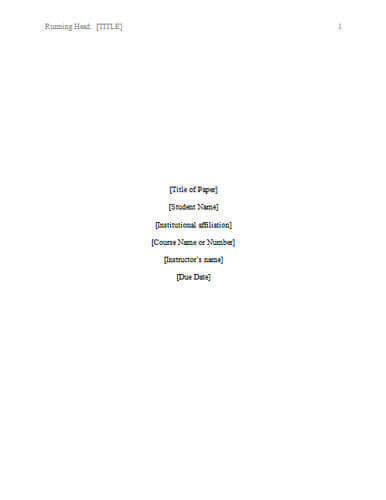APA CITATION STYLE

APA
- This citation style is used widely among the medical fields, psychology, sociology, sports and rec, social sciences, research fields but can be used by any discipline.
- "American Psychological Association"
- Citations styles (APA, MLA) will help establish your credibility as a writer/scholar.
- APA and other styles are concerned with writing on an academic level (in-text citations, paraphrase, signal phrases, works cited, reference page)
Format on 1st page
- Double Space
- 1" margins
- Times New Roman, Arial, Calibri
APA requires a TITLE PAGE which contains
- Header with
- Running Head: TITLE (ALL CAPS)
- Page Number
- Every other page will have the TITLE in ALL CAPS AT THE TOP


APA Reference Page
- It comes at the end of your essay
- It is supposed to be on its own separate page.
- You need this page if you are citing from sources but also using information from a source you don't plan to cite.
- ALPHABETIZE YOUR AUTHORS BY LAST NAME.
- CREATE A HANGING INDENT: For PCs, highlight and press CTRL T, for Macs hit COMMAND T, CTRL T, Or Adjust Line Spacing option.

WHAT'S THE ORDER FOR APA CITATIONS?
1. AUTHOR
2. (DATE)
3.Title of source
4. OTHER CONTRIBUTORS (Eds.)
5. TITLE OF CONTAINER (italicize)
6.VOLUME/NUMBER ex: 89(2)
7. (PAGE NUMBERS)
8. PLACE OF PUBLICATION: PUBLISHER
9. ONLINE LOCATION (URL, DOI)

DATE

In APA, you want to avoid any gender bias, so author's first names are in initials = Smith, B.B. and Hollins, F.T.
Always include year, (month if given) within paranthesis followed by a period.
Ex. James, S.H. (1998).
TITLE OF SOURCE
- Don't use quotes, italics, or underlining for source.
- Capitalize first word and then everything else is lower case
- However, if you encounter a : (colon), capitalize after that
- Ex:
Jackson, K.L. (1992). Primate aggression towards zoo keepers: Should animals be caged?
OTHER CONTRIBUTORS
- You list editors, translators, or artists here. Remember, only last name and initials.
- Example: In H.N. Houseman and K.L. Lowry (Eds.),
Follow this with a comma before you mention the book.
Version
Number
Within APA, you will simply list the volume and issue (number) after the book, journal, or periodical in the citation *NOTE: THIS ONLY APPLIES FOR ONLINE ARTICLE SOURCES FROM A DATABASE.
LOOKS LIKE THIS: 67(2)
Title of Container
- Remember, the larger book is listed after your source or article. In APA, you will italicize this as well.
PAGES
- In APA, you will include the page numbers in (paranthesis) if they come from a collection, anthology.
- If the pages are from an online database, you would only list the page range with no paranthesis.
PUBLICATION PLACE AND GROUP
- First, list the place of publication followed by a colon:
- List the publisher name after the colon.
- *NOTE, THIS APPLIES TO PRINTED BOOKS, ANTHOLOGIES.
APA (continued)
- References (seperate page at the end)
- In-Text Citations
- This is where you show physical proof of using a source in your paper.
- You don't want to list something in References if it doesn't show up in the main body.
- In-Text and references work together to establish your credibility
- Two types of In-text citations
Online Location
IN APA, YOU WILL STILL INCLUDE THE DOI, OR URL AT THE END OF THE CITATION.
In-Text Citations
- Direct Quote
- With these you are taking the material right from your source without altering anything.
- In APA it would look like:
- "Marine biology is a study that might be greatly needed in upcoming years if ocean levels continue to rise" (Ridgefield, 1999, p. 76).
- NOTE: Within APA style, Direct Quotes are usually discouraged throughout most of the paper. In most cases you only want to rely on using one or two brief direct quotes.
In-Text Citations
- Paraphrase: This is where you cite a source but put it into your own words
- In APA, you want to rely more heavily on paraphrase instead of Direct Quote.
-
- Very useful feature of citation: Allows you to shorten long, and confusing passages to make sense.
- Summary: Sometimes you can also combine similar ideas by more than one author together
- For Example: The use of data by computer programmers was found to catalog algorithms that tracked user search predictions (Hicks, 2019; Watts, 2009)
Side By Side, In APA
- "The perplexed man of sluggish disposition walked his obese dog down the perpetual sidewalk" (Smitee, 2014, p. 89).
OR you can break up the citation with SIGNAL PHRASES
According to the Smitee (2014), the confused, lazy guy paced down the long sidewalk with his fat dog (p.89)
MLA VS.
- All personal/course information is on the first page with content.
- HEADER only includes last name and page #
- Can use Direct Quotes and Paraphrase fairly equally.
- Can refer to authors first name, he/she
- In text citations in paranthesis should include (Last name #) (Roberts 89)
APA
- All personal/course information is on its own cover page.
- HEADER on cover page has Running head: TITLE (all caps), and every page has TITLE and page number in header.
- Mostly rely on paraphrase.
- Avoid gender bias
- In text should include: (Last name, date, p. #)
COMPARE/CONTRAST
APA (conclusion)
- Makes use out of abstracts, appendices, results, or other sections. NOTE: Ask your instructor whether this is necessary.
CONSULT ONLINE RESOURCES (PURDUE OWL APA, MLA, or LIBGUIDES) OR PRINT SOURCES,
APA Citation Style
By codys
APA Citation Style
Basic formatting and listing for this citation style
- 292



